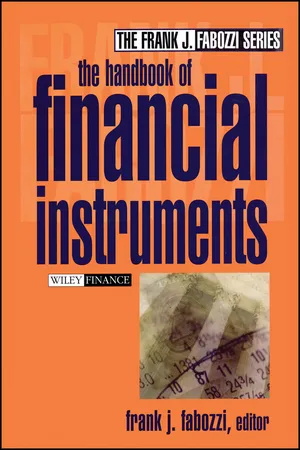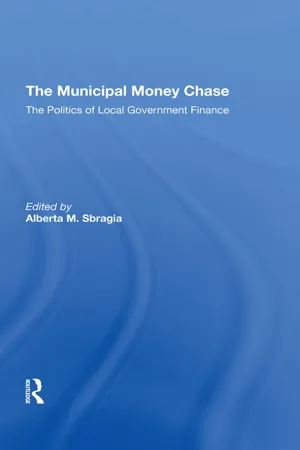Economics
Municipal Bonds
Municipal bonds are debt securities issued by state or local governments to raise funds for public projects such as schools, roads, and utilities. Investors who purchase municipal bonds are essentially lending money to the issuing government in exchange for regular interest payments and the return of the bond's face value at maturity. Municipal bonds are often exempt from federal taxes and, in some cases, state and local taxes, making them attractive to investors in higher tax brackets.
Written by Perlego with AI-assistance
Related key terms
1 of 4
Related key terms
1 of 3
10 Key excerpts on "Municipal Bonds"
- eBook - ePub
The Handbook of Traditional and Alternative Investment Vehicles
Investment Characteristics and Strategies
- Mark J. P. Anson, Frank J. Fabozzi, Frank J. Jones(Authors)
- 2010(Publication Date)
- Wiley(Publisher)
CHAPTER 6Municipal SecuritiesDebt obligations issued by state and local governments (municipalities, counties, and townships) and by entities that they establish are generically referred to as municipal securities or Municipal Bonds. The primary attractiveness of Municipal Bonds is that the interest earned is exempt from federal income taxation. While not all municipal securities are exempt from federal income taxation, tax-exempt Municipal Bonds are the largest component of the market. However, in 2009 the federal government introduced a new type of taxable bond, Build America Bonds, that significantly increased the size of the taxable sector of the municipal bond market.In this chapter, we discuss the types of debt obligations issued by states, municipal governments, and public agencies and their instrumentalities, and the investment characteristics of these financial instruments.TAX-EXEMPT AND TAXABLE MUNICIPAL SECURITIES
There are both tax-exempt and taxable municipal securities. “Tax-exempt” means that interest on a municipal security is exempt from federal income taxation. The tax exemption of municipal securities applies to interest income, not capital gains. The exemption may or may not extend to taxation at the state and local levels. The state tax treatment depends on (1) whether the issue from which the interest income is received is an “in-state issue” or an “out-of-state issue,” and (2) whether the investor is an individual or a corporation. The treatment of interest income at the state level will be one of the following:1. Taxation of interest from municipal issues regardless of whether the issuer is in state or out of state. 2. Exemption of interest from all municipal issues regardless of whether the issuer is in state or out of state. 3. Exemption of interest from municipal issues that are in state but some form of taxation where the source of interest is an out-of-state issuer. - eBook - ePub
The Capital Markets
Evolution of the Financial Ecosystem
- Gary Strumeyer(Author)
- 2017(Publication Date)
- Wiley(Publisher)
CHAPTER 24 Municipal Bonds Fred Yosca INTRODUCTION Municipal Bonds are debt instruments issued by states and their political subdivisions such as counties, cities, towns, school districts, and governmental agencies. When you purchase new‐issue Municipal Bonds, you are in effect lending money to finance various public projects such as the construction of hospitals, highways, and schools or the purchase of subway cars and garbage trucks. As the infrastructure of our country continues to age and the population increases, the amount of capital needed to rebuild, rehabilitate, and construct new roads, bridges, mass transit systems, and water and sewer systems will grow. The municipal bond market is the preferred venue in which those financings take place. What distinguishes Municipal Bonds from other fixed‐income investments is their tax treatment. The interest paid by municipalities on bonds issued to finance public‐purpose projects such as the ones cited earlier are exempt from federal income taxes. In most cases, states do not tax the interest income generated by the bonds they issue or the bonds issued by their political subdivisions. For example, a New York resident who purchases a bond issued by New York State or any of its political subdivisions would not have to pay federal or state income tax on the income produced by this bond. For a New York City resident purchasing an instate bond the interest is exempt from New York City income tax as well. Conversely, bonds that are issued for a nonmunicipal purpose, such as the funding of employee pensions, are fully taxable at the federal level. The last category of tax treatment for Municipal Bonds concerns bonds that are subject to the federal alternative minimum tax (AMT). Bonds whose proceeds are used for private‐purpose activities such as financings for corporations or other nongovernmental purposes will be subject to AMT - eBook - ePub
Investing in Fixed Income Securities
Understanding the Bond Market
- Gary Strumeyer(Author)
- 2012(Publication Date)
- Wiley(Publisher)
Chapter 10
Municipal Bonds
Over the past 10 years, the municipal market has become much more appealing to individual investors. The proliferation of bond insurance, the adaptation of municipal market data (MMD), the market’s main benchmark, electronic commerce network (ECN) trading, and increased price transparency have led many investors to believe that buying tax-free bonds is as simple as purchasing equities. This is not the case. Successful municipal bond investing necessitates a full understanding of relative value. Each municipal bond possesses unique characteristics that influence the price and thus the return on the securities. Not even all AAA bonds are created equal!Municipal Bonds are bonds issued by states and their political subdivisions: counties, cities, towns, school districts, and other governmental bodies.When you purchase new Municipal Bonds, you are in effect lending money to local governments in order to finance various public projects. For example, funds can be raised to build hospitals, schools or to repair the infrastructure.What distinguishes these bonds from other fixed income investments is the tax-exempt status of the interest paid by the municipality. Interest income received on municipal investments is not subject to federal taxes. Also, in most cases, states do not tax the interest income generated by bonds issued by that state or by any of its political subdivisions. For example, a New York State taxpayer who purchases any bond issued by New York State or any of its governmental bodies would not have to pay federal, state, or local taxes on the income produced by this bond. The interest is thus deemed to be triple tax-free for the New York City resident purchasing home-grown bonds.There are three general categories of Municipal Bonds: general obligation bonds, revenue bonds, and prerefunded/escrowed to maturity bonds.1. General obligation bonds (GOs) - eBook - ePub
- (Author)
- 2011(Publication Date)
- Wiley(Publisher)
Chapter 2 The Basics of Municipal Securities DESCRIPTION OF MUNICIPAL SECURITIESThe municipal market includes different types of municipal securities. Traditional Municipal Bonds are interest-bearing securities issued by state and local governments on their own behalf or on behalf of qualified entities to finance capital projects and certain cash flow needs. Because interest on most of these securities is exempt from taxation at the federal level and sometimes at state and local levels, they are also called tax-exempt bonds . Build America Bonds, and certain other categories of bonds created by the American Recovery and Reinvestment Act of 2009, are subject to federal, state, and local taxes, however; they are taxable bonds .The par value, face value, or principal amount is what is paid to investors when the security comes due or matures, with interest having been paid throughout the life of the security. Generally, when a security matures in one year or more, it is a long-term financial instrument and is called a bond. Municipal Bonds usually have maturities ranging from 1 to 30 years, although some bonds have been issued with maturities ranging from 40 to 100 years. Generally, when a security has a term of less than 13 months, it is a short-term instrument. Municipal short-term instruments include notes and commercial paper. Variable-rate demand obligations (VRDOs) usually have short-term interest rate resets—and so are often treated by the market as short-term securities—but the final maturity of the security is usually long term. Zero coupon bonds do not pay interest periodically; instead, the interest accrues at the stated yield until maturity.Municipal Bonds are typically issued in denominations of $5,000 or integral multiples of $5,000, but some market terminology is based on a $1,000 bond. For example, a dealer who says “one bond” is typically referring to $1,000 par value. “Twenty-five bonds” are $25,000 par value, although there may be only five units in denominations of $5,000 each. Some municipalities have experimented with denominations as small as $100 to try to attract smaller investors, but the practice has not become widespread. - Holley Ulbrich(Author)
- 2013(Publication Date)
- Routledge(Publisher)
- The deficit is the gap between spending and revenue in a particular year (a surplus if revenue exceeds spending). The debt is the cumulative result of past surpluses and deficits, the stock of government IOUs that must eventually be repaid and that generate a debt service obligation in the current year’s budget. Debt service refers to payments of interest and repayments of principal as an operating expense.
- The federal government does not have any significant constraints on borrowing, but state and local governments usually are subject to a balanced budget requirement. They can, however, borrow for capital spending, primarily for infrastructure, or public physical capital, such as roads, airports, school buildings, water and sewer systems, and parks.
- About 40 percent of federal debt is held by public agencies, with the remainder divided between private domestic investors and foreign governments and investors.
- Most public sector capital is financed by borrowing, or issuing bonds. Interest on state and local government bonds, called Municipal Bonds, is generally exempt from federal income taxes. General obligation bonds are backed by the taxing power of the government, while revenue bonds are secured by expected income from the capital project.
- Any rationale for public sector capital relies on arguments of market failure, including public goods (low rivalry, low excludability), merit goods, or positive externalities; monopoly characteristics of some kinds of services provided with public infrastructure; or lack of private financing because of risks of various kinds.
- State and local governments use capital financing to spread the cost over the useful lifetime of the capital project and to distribute the burden of payment equitably among present and future taxpayers. Their borrowing is called Municipal Bonds, with interest exempt from federal income taxes The taxable equivalent yield on a municipal bond is equal to the nominal yield times 1 + t, where t is the taxpayer’s marginal federal income tax rate.
- Public financing of infrastructure raises issues of interpersonal (rich versus poor, users versus nonusers, etc.) and intergenerational equity (present versus future citizens/users). Among the newer methods of financing infrastructure are the use of public–private partnerships, state guarantees and debt subsidies, and creating special districts for the sole purpose of developing and financing infrastructure.
- eBook - ePub
- Frank J. Fabozzi, Frank J. Fabozzi(Authors)
- 2018(Publication Date)
- Wiley(Publisher)
The number of municipal bond issuers is remarkable. One broker/ dealer’s estimate places the total at 60,055. Also, Bloomberg Financial Markets’ (Bloomberg) database contains 55,000 active issuers. Even more noteworthy is the number of different issues. Interactive Data, a company that provides pricing information for institutional investors, claims that it provides daily prices for more than 1.2 million individual issues in its database. Bloomberg’s database contains 1.7 million issues with complete description pages.In this chapter, we discuss the types of debt obligations issued by states, municipal governments, and public agencies and their instrumentalities. These securities are popularly referred to as municipal securities, although they are also issued by states and public agencies and their instruments.TAX-EXEMPT AND TAXABLE MUNICIPAL SECURITIES
There are both tax-exempt and taxable municipal securities. “Tax-exempt” means that interest on a municipal security is exempt from federal income taxation. The tax-exemption of municipal securities applies to interest income, not capital gains. The exemption may or may not extend to taxation at the state and local levels.The state tax treatment depends on (1) whether the issue from which the interest income is received is an “in-state issue” or an “out-of-state issue,” and (2) whether the investor is an individual or a corporation. The treatment of interest income at the state level will be one of the following:- taxation of interest from municipal issues regardless of whether the issuer is in-state or out-of-state
- exemption of interest from all municipal issues regardless of whether the issuer is in-state or out-of-state
- exemption of interest from municipal issues that are in-state but some form of taxation where the source of interest is an out-of-state issuer.
For individuals, for those states that have a state income tax, only the following states tax interest income from in-state issuers (although there may be some exceptions for certain out-of-state issues): Illinois, Iowa, Kansas, Oklahoma, and Wisconsin. Exhibit 10.1 identifies those states for which out-of-state issues are exempt from taxation. This exhibit also shows the maximum state tax rate on municipals and the effective state tax rate on municipals. (We’ll see what the last three column in Exhibit 10.1 - eBook - ePub
The Economy of Promises
Trust, Power, and Credit in America
- Bruce G. Carruthers(Author)
- 2022(Publication Date)
- Princeton University Press(Publisher)
83Who purchased municipal and other government bonds? Which creditors decided to lend to U.S. towns, cities, and states? Doubtless many individuals purchased such bonds, but starting in the middle of the nineteenth century, institutional investors played a significant role. Life insurance companies, for example, had a great fondness for bonds. Partly this was dictated by state regulation but also by the absence of good investment alternatives.84 As sellers of life insurance, insurance companies acquired substantial long-term obligations: rising life expectancies meant that cash payouts had to be made at a point in the distant future. To meet long-term obligations, they had to invest the premiums they received in long-term assets that safely generated a positive long-term rate of return. Bonds were an obvious choice. Thus, in 1865 about 35 percent of all life insurance company assets were invested in bonds. The proportions for 1895, 1925, 1955, and 1985 were 36, 38, 53, and 51 percent, respectively.85 For a long time insurance companies have included bonds as a significant component of their investments. Mutual savings banks were another financial institution that purchased state and local government bonds. In 1896, about 25 percent of the total assets of mutual savings banks were in such bonds.86 The proportions for 1925 and 1955 were 9 and 2 percent, respectively, a substantial decline that reflected the growing importance of U.S. government bonds and mortgage loans on mutual savings bank balance sheets. The annual report of the Ohio Department of Banks and Banking reveals that Municipal Bonds were a significant asset for state-chartered banks. In 1914, more than 9 percent of assets held by Ohio state banks consisted of state, county, or Municipal Bonds (of course, most bank assets consisted of loans).87 The proportions were lower for Illinois state-chartered banks in 1916, where about 3.5 percent of total bank assets were in state, county, or Municipal Bonds.88 And in 1912, about 17 percent of security holdings of national banks were in state, county, or Municipal Bonds.89 Later in the post–World War II era, most investment in Municipal Bonds came from high-income individuals (who benefited from their tax-exempt status), banks, and insurance companies.90 - eBook - ePub
- William L. Raymond(Author)
- 2018(Publication Date)
- Routledge(Publisher)
Let us examine this table. Bonds issued for general government properties, for police and fire departments, for sewers and sewage disposal and for highways obviously are issued for public purposes. About the government properties and the police and fire departments, there is no question as to general public benefit. They exist for the good of the people as a whole; and they are necessary and useful. Bonds issued in reasonable amounts for such purposes are entirely proper. As to sewers, the only question that may arise is as to whether the sewers serve, in a broad sense, the people of the whole community or the people of a certain section only. When the latter is the case, sewer bonds often are issued as special assessment bonds — that is, as bond payable out of assessments levied on abutting or benefited property and not out of taxes levied on all the property within the community. Special assessment bonds are not, strictly speaking, Municipal Bonds at all. Sewers may be considered necessary and useful purposes.Here it may be well to refer briefly to the length of time which Municipal Bonds shall have to run. In general, the bonds should not remain outstanding longer than the probable existence of the property for which they are issued. This, again, depends on the character of the property. In many communities, there has been great laxness in issuing Municipal Bonds having maturities beyond the probable life or usefulness of the work. This phase of our subject we shall take up later.Bonds issued for highway purposes are for purposes of benefit to the general public and for purposes that may be considered necessary and useful. In highway construction, two or more cities and towns may act concurrently.Charities, hospitals and corrections are public and also, within limits, necessary and useful purposes. Bonds should be issued, of course, only for buildings or other more or less permanent structures in connection with such activities.School buildings are among the very best of purposes. Under the American system of universal and often compulsory education, bonds issued for schoolhouses may be thought of as issued for a strictly public purpose and for a purpose highly useful and beneficial. Probably the people of almost any American community would struggle hard to avoid default on any obligations incurred in connection with the public school system.Libraries, art galleries and museums, and also parks and playgrounds, are to be thought of as distinctly public purposes. Such places, when created and owned by the municipalities,1 - eBook - ePub
The Municipal Money Chase
The Politics Of Local Government Finance
- Alberta Sbragia(Author)
- 2019(Publication Date)
- Routledge(Publisher)
The Rating Game: Report of the Twentieth Century Fund Task Force on Municipal Bond Credit Ratings (New York: The Twentieth Century Fund, 1974), p. 1.28 . The national bond market does not, however, provide all of the funds borrowed by state and local governments. Lamb and Rappaport point out that many municipal issues “are really small- to moderate-sized loans to municipalities for such things as a fire engine, school bus, or bridge. These bonds might not ever truly enter the national public bond market at all.” These municipal issues are “tailor-made” for local banks and “will probably never be resold or leave the community, the state, or indeed the bank’s vault” (Lamb and Rappaport, Municipal Bonds, p. 28). The aggregate dollar volume of “local bonds,” however, is very small compared to that of bonds sold in the national market. The federal government also loans some funds to local governments. In 1975, “federal loans to states and local governments for only six major functions totaled over $1.5 billion” (Deil S. Wright, Understanding Intergovernmental Relations [North Scituate, Mass.: Duxbury, 1978], p. 126).29 . For a more detailed account of the processes and technicalities involved in buying and selling Municipal Bonds in the national market, see Lamb and Rappaport, Municipal Bonds, pp. 40-50; Walsh, The Public’s Business, pp. 55-80; Alan Walter Steiss, Local Government Finance: Capital Facilities Planning and Debt Administration (Lexington, Mass.: Lexington Books, 1975), pp. 103-151.30 . Moody’s Bond Record, September 1981, p. 129.31 . Unrated bonds are usually “local” bonds and are bought by local banks.32 . Alan D. Mutter and Harry Golden, Jr., “Lower Rating Could Cost City $3.6 Million,” Chicago Sun-Times, 20 September 1979.33 . Lamb and Rappaport, Municipal Bonds, pp. 58-72.34 . Wes Hills, “Dayton Fights Downgrading of Its Bond Rating,” Dayton Daily News, 26 July 1979; Dave Allbaugh, “Dayton Plans to Issue Bonds Despite Rating, Dayton Daily News, 28 July 1979.35 . John Leach, “Top Bond Ratings Elude City and County Because of Growth Rate,” Phoenix, Arizona Republic, 21 October 1979.36 . Jo Mannise and Phil Sutin, “Dispute May Affect City’s Credit,” St. Louis Post-Dispatch, - eBook - ePub
Cornell Studies in Political Economy
American Bond Rating Agencies and the Politics of Creditworthiness
- Timothy J. Sinclair(Author)
- 2014(Publication Date)
- Cornell University Press(Publisher)
12In Europe, growth of interest in municipal debt issuance reflects an environment of financial liberalization, the empowerment of local governments relative to national governments, and the disintermediation of finance.13 As Dyer notes, “Devolved power means that local authorities need to borrow more to finance spending and investment.”14 Indeed, in France since 1982, Ministry of Finance records show that “the debt level per inhabitant in the régions has increased by 370%.”15 Polish cities began issuing debt in 1996, with the explicit aim of attracting inflows of foreign capital.16 To meet the Maastricht criteria for entry into the European Union, central governments were required to reduce budget deficits, thereby effectively pushing subnational communities to shoulder greater financial burdens.17 At the same time, local finance providers like France’s Credit Local have withered, given the competition from the capital markets. Banks have too, because shareholders are unwilling to see loans made to municipalities at rates not competitive with the market.Table 6. Mechanics of Moody’s municipal rating processSource: Moody’s Investors Service, Moody’s on Municipals (New York, 1991), 42.The legal and regulatory environment has also become more permissive of debt issuance by territorial communities. In this new market, the city of Moscow became an important player and Moody’s upgraded the city a number of times from mid-2000 onward, despite the Russian sovereign defaults of 1998.18 Even obscure cities in Siberia and Tartarstan made plans to get ratings in the late 1990s.19 Moody’s and S&P have set targets for 30 percent of their revenues to come from non-U.S. ratings.20
Index pages curate the most relevant extracts from our library of academic textbooks. They’ve been created using an in-house natural language model (NLM), each adding context and meaning to key research topics.
Explore more topic indexes
Explore more topic indexes
1 of 6
Explore more topic indexes
1 of 4









